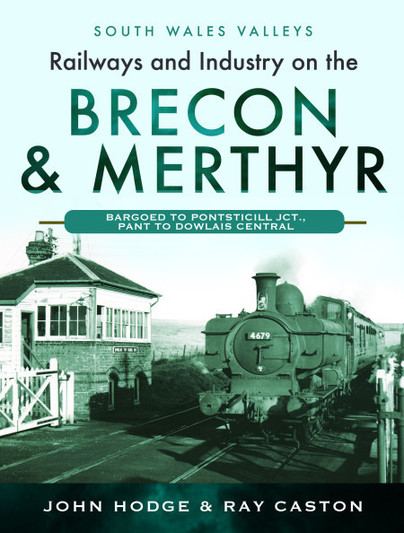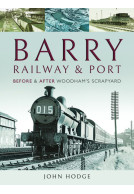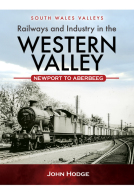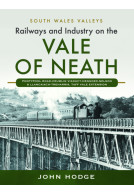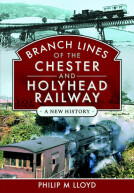Railways and Industry on the Brecon & Merthyr (Hardback)
Bargoed to Pontsticill Jct., Pant to Dowlais Central
Imprint: Pen & Sword Transport
Series: South Wales Valleys
Pages: 120
ISBN: 9781399070768
Published: 4th October 2022
(click here for international delivery rates)
Order within the next 9 hours, 54 minutes to get your order processed the next working day!
Need a currency converter? Check XE.com for live rates
| Other formats available - Buy the Hardback and get the eBook for £1.99! | Price |
|---|---|
| Railways and Industry on the Brecon… ePub (184.8 MB) Add to Basket | £9.98 |
This book on the Brecon & Merthyr, deals with the section from Bargoed to Pontsticill Junction, covering the line built by the B&M to join onto the section running north from Bargoed built by the Rhymney Railway, much dominated at the time by nearby Dowlais Ironworks. Included is the short section from Pant to Dowlais Central. It contains photographs of every location along the line, including many that have not before been published. The volume includes a fascinating account of the Pantywaun Marshalling Yard, operative until Dowlais Ironworks ceased production, when the B&M ran freight services to and from Pantywaun, before the many collieries and levels in the area were closed almost overnight and the location finally obliterated under the development of Cwmbargoed Opencast.
“Another comprehensive collection of images and text… There then follows a journey along the lines, each section described with the aid of maps and filled with hundreds of superb photographs covering the time span from early days to final days, all of the best quality and reproduced on quality paper such that I find it difficult to find the words to convey the excellence of the book. The authors have excelled themselves in finding the quantity and quality of the images that I find it difficult to put the books down.”
Great Eastern Railway Society Newsletter
This is the second volume in the publisher’s planned series of three on the Brecon and Merthyr Railway. It covers the central section of the route which climbs over the bleak uplands of north Glamorganshire and includes the short branch to Dowlais.
Journal of the Railway & Canal Historical Society
As with other books on the railways in the South Wales Valleys from this publisher it is profusely illustrated with photographs of all the stations and key locations together with reproductions of large-scale Ordnance Survey maps. Most of the photographs are from the post-Nationalisation era and have reproduced well.
After an introductory section on the history of the line there is a chapter on train services following the 1924 Grouping with further analysis of passenger and freight services in the 1950’s and individual chapters on each station. This book is well up to the publisher’s usual standards.
The second part of John Hodge and Ray Caston’s Brecon & Merthyr work covers the central part of the line which served collieries around Fochriw and further south, as well as the ironworks at Dowlais. The sections of line included feature scenery typical of many South Wales valleys, but the northern end is somewhat bleak and windswept, and this contrast is well represented in this book.
West Somerset Railway Association
Following the authors’ previous format, this volume is essentially a quality photographic album illustrating the route in considerable detail, and amplified descriptions of each key location are provided in the accompanying narrative, both in terms of railway infrastructure and the local industry it served. An extract from the six inch Ordnance Survey map of around 120 years ago is provided for most locations, and this proved most helpful in clarifying the complicated junction arrangements and industrial sidings which are a prominent feature of the route. Another very useful addition is the summary of timetables of passenger and goods services in 1924 and 1958/9 which will assist the modeller in recreating the contemporary railway scene. Other information provided explains how services were designed around the shift changes in the local coal mines. Towards the end of the book, there is a short history of the Dowlais Ironworks and associated industries, including their development under successive generations of the Guest family, through to closure as part of the British Steel Corporation.
The historic illustrations in this series are no doubt its highlight, and this volume does not disappoint. The authors have had access to images from several sources, and this includes for example the work of Sid Rickard, Bob Tuck and Trevor Owen, to name but a few. As a result, very extensive coverage is available of locations such as Bargoed and Dowlais Top, with no less than three dozen images of the latter station and its environs, mostly captured in the 1950s and 1960s. For those with an interest in earlier locomotive history, there are several quality views of Brecon & Merthyr Railway saddle tanks at work around the time of the Grouping, mostly originating with the LCGB collection. Carriage enthusiasts will enjoy the shot of a flat-sided former Rhymney Railway third on the Dowlais to Pant service. Despite having access to a large collection of illustrated books on the railways of South Wales, this reviewer was unaware that there was ever a timetabled DMU service serving Fochriw and Dowlais Top: it is clear from one picture that this was far from a one-off event as the cab is fitted with a destination blind showing Fochriw!
In summary, this is another exceptional work from the authors and is excellent value at £25.
This is the second of three volumes in the series covering the B&M Railway – the first volume was reviewed in IL 183. This one covers the lines from Bargoed to Pontsticill Junction and Pant to Dowlais Central. There are 3 chapters; the first covers the various train services on the line after the Grouping in 1923. The second covers each of the locations on the first section of line mentioned above and the third the ones on the second section of line.
Industrial Locomotive Society
There is a wide variety of photographs showing both train services and industrial locations. Quality varies but no doubt this reflects the condition of the originals. There are copies of old OS maps covering the areas in question. There are a few photos of industrial locomotives. The book will certainly be of interest to members who would like to know more about the area.
The first volume of what the authors state will be a trilogy on the Brecon & Merthyr covers the Mainline from Bargoed to Pontsticill Jet and then the short branch from Pant to Dowlais central. The maize of lines constructed by competing companies in adjacent valleys and often either side and criss cross crossing the myriad of valleys that was home to the South Wales Coalfield is to many a confusing network. By taking one line at a time and with a good scaled plan, the authors have unravelled the B & M from its competitors, although initially running over the Rhymney Railway from the start of the books coverage at Bargoed until commencement of B & M ownership at Deri Junction.
6024 Preservation Society
The outlining of various passenger services over the years in Chapter 1 is interesting, as is the circuitous route of the Central Wales stores van. There then follows a good description of each station along the lines, all featured with good informative captions. A few early Edwardian photographs have been included but the majority are B & W 1950’s / 60’s views. Nothing wrong with them, although it feels that for some stations in order to ‘Pad out’ a dearth of different views, the same train has been photographed from every angle possible and every photo taken on that journey included in the volume.
The massive Dowlais iron works features but briefly at the end of the book which was of course the main reason for the B & M striving to reach the area in the early 1800s. Reproduction of photographs is good given their age and it will be interesting to see the subsequent volumes and follow the line Northwards to Brecon.
As featured in
Steam Days - March 2023
This is the second of three planned volumes on the B&M. The series style is maintained with detailed photographic captions adding to the text.
Welsh Railways Research Circle Newsletter, No.172 Winter 2022/23
This volume is best enjoyed after reading Volume 1 which provides the groundwork. I’m pleased to have both in my library. Roll on volume 3 to complete the story…
A helpful work on a neglected railway. There is much here to help historians and modellers so it is a welcome addition to the shelves.
The Journal of the friends of the National Railway Museum Winter 2022-23 (No.182)
An engaging portrait of the locations to be found in the middle section of the Brecon and Merthyr Railway, mainly during the 1950s and 1960s.
Books on the Line
Read the review here
Of South Wales railways the Brecon and Merthyr was one of the smaller but with a surprisingly reach. This book follows a previously successful formula linking railways with the histories of the industries they served. There is plenty here for students of South Wales railways.
Welsh Railways Research Circle Newsletter
Obviously a major traffic was coal and the histories of collieries along the route are covered. The once large Dowlais iron works features but there is less about the nearby ICI ammonia works, though the long distance trains from it feature with excellent photographs. There is an interesting picture of the powerful looking Dowlais Works shunters decorated and named for a royal visit. It is striking how these resemble the Hornby clockwork tinplate 0-4-0 engines. Were they the originals?
Photographs cover what appears to be every station and halt on the line, some show the scenes after closure. Their isolated locations are well brought out. The Heads of the Valleys area was and remains a bleak area.
Along the line to the south Bargoed features prominently. One wonders what happened to The Emporium, prominently advertised at the station as “The largest store in the valley”. “Darran and Deri” seems an unlikely station name but here are photos to prove its existence.
There are OS maps and details of train services.
A helpful work on a neglected railway, there is much here to help historians and modellers so it is a welcome addition to the shelves.
About John Hodge
The late John Hodge was a former railwayman, who started his working life on the Western Region in South Wales in 1961, later transferring to London Paddington and British Railways Board. He was brought up in Barry, a port town west of Cardiff, which has strong railway connections, once being an important port for coal traffic and later being famous for Woodham Brothers scrap yard, and which held over 200 locomotives that are now mostly preserved on heritage lines. John was a lifelong railway enthusiast and historian, with many railway histories published.
About Ray Caston
Ray Caston is a former chemist, working for Monsanto’s at Newport. He has lifelong association with the B&M where his father and grandfather were both employed. He has lived all his life at Bassaleg where he is a local councillor. Since 1970 he has maintained a continuous interest in the operation and history of the B&M line, Bassaleg being its southern terminus. He has a wide knowledge of the South Wales railway scene and is a valued member of local railway societies.







